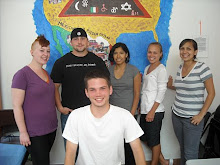 CGE students in front of the site
CGE students in front of the siteThis past weekend, our students had the opportunity to accompany a local art professor on a day-long excursion to Cholula and Puebla, one of the very first Spanish settlements during the colonial period and currently a UNESCO World Heritage Site. The visit consisted mostly of viewing different cathedrals in the area, the state of Puebla being famous for its abundance of churches!
During their first stop in Cholula, an important pre-Columbian Mesoamerican city, students visited a very unique archaeological site. They first explored the tunnels of Tlachihualtepetl, also known as the Great Pyramid of Cholula and said to be the largest monument of its kind in the world (based on volume). Now, the pyramid is located under a large land mass and a Spanish church, Santuario de la Virgen de los Remedios. It was an interesting juxtaposition of the old and the new Mexico—and yet another example of pre-Hispanic civilizations being appropriated by the Spanish during colonization and altered to serve their own purposes.
Once in the city of Puebla itself, the students’ first stop was the Puebla Cathedral, located right in the historical city center near the zocalo (city square). The students learned the history and significance of this cathedral, a Roman Catholic Church built in the 16th and 17th centuries. They were also able to view the Poblano mosaic tiles so typical of Puebla. At the Iglesia de Santo Domingo as well, Poblano art and architecture was studied, and the Arabic influences from the Spanish colonists were discussed as well.
All in all, the Puebla excursion was a great look into Mexican art and architecture for the CGE students. Does anyone else have any experiences they want to share about this amazing place?
During their first stop in Cholula, an important pre-Columbian Mesoamerican city, students visited a very unique archaeological site. They first explored the tunnels of Tlachihualtepetl, also known as the Great Pyramid of Cholula and said to be the largest monument of its kind in the world (based on volume). Now, the pyramid is located under a large land mass and a Spanish church, Santuario de la Virgen de los Remedios. It was an interesting juxtaposition of the old and the new Mexico—and yet another example of pre-Hispanic civilizations being appropriated by the Spanish during colonization and altered to serve their own purposes.
Once in the city of Puebla itself, the students’ first stop was the Puebla Cathedral, located right in the historical city center near the zocalo (city square). The students learned the history and significance of this cathedral, a Roman Catholic Church built in the 16th and 17th centuries. They were also able to view the Poblano mosaic tiles so typical of Puebla. At the Iglesia de Santo Domingo as well, Poblano art and architecture was studied, and the Arabic influences from the Spanish colonists were discussed as well.
All in all, the Puebla excursion was a great look into Mexican art and architecture for the CGE students. Does anyone else have any experiences they want to share about this amazing place?


Sounds like a great trip! It is no small feat to earn the title of UNESCO World Heritage Site. Puebla has a lot of tradition and a long history. I think it is very interesting that the art in the two cities have so many different influences. There is a lot of influence from Catholicism because it was so instrumental in the conquest of Mexico. Also, the fact that there is art in Mexico that has Arabic influence is impressive, not something you might guess. It is a good thing you guys made a whole day trip out of the excursion because there is so much to see. Awesome!
ReplyDeleteGoing to Cholula and Puebla was very interesting for me after taking the Mexican art history class. It gave me a chance to see how Mexican art transformed from the period before the conquest to the 18th century. At the beginning we were able to see indigenous artwork at the pyramid in Cholula. One thing that was very interesting was that the different pyramids formed an area that created an echo. Also, it was very interesting to see that the Spanish built a church on top of an indigenous site that they did not know was there. Traveling to Puebla we were able to see how art had changed in Mexico after the Spanish arrived at the cathedral. The cathedral had a very baroque style that left no space empty and did not use straight lines. All in the entire trip to Cholula and Puebla was very educational and fun.
ReplyDelete